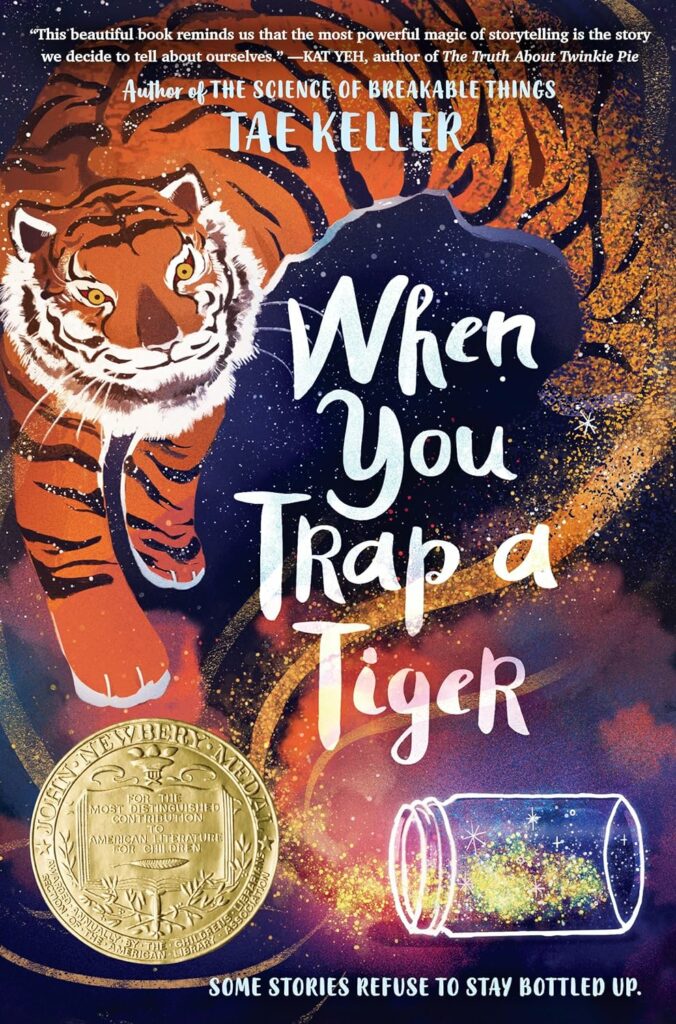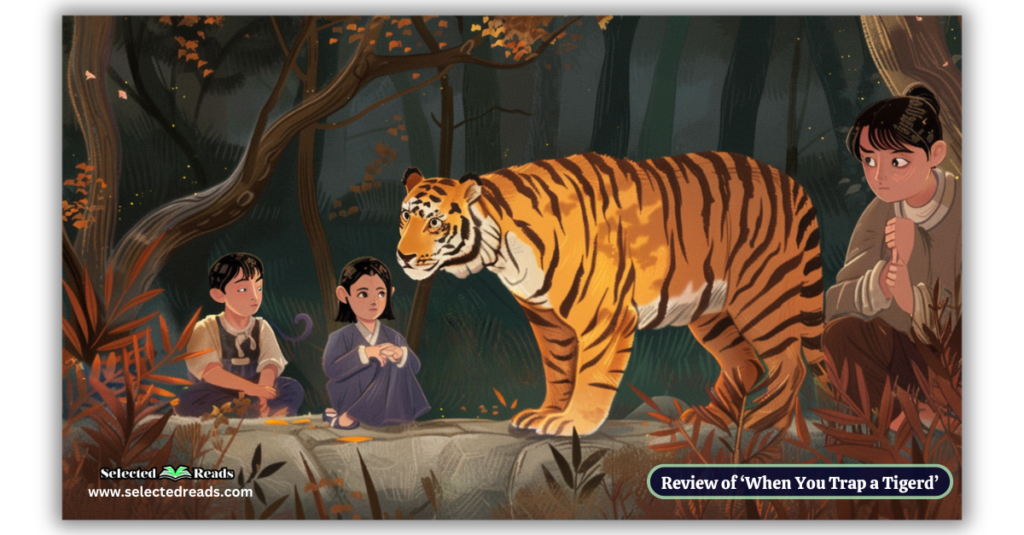Today, we’re delving into the rich tapestry of “When You Trap a Tiger” by Tae Keller. This award-winning novel beautifully merges elements of Korean folklore with the intricate dynamics of family life. The aim of this post is to give you a comprehensive overview of the novel, highlighting its story, characters, and the cultural backdrop, all while keeping major plot revelations under wraps.
Our discussion will unfold in three segments: starting with an in-depth summary of the novel’s plot, followed by an analysis of its key characters, and concluding with a series of engaging book club questions designed to deepen your understanding and appreciation of the book.
When You Trap a Tiger Summary
“When You Trap a Tiger” by Tae Keller is an enchanting tale interwoven with Korean folklore and a heartfelt journey into family secrets and the power of stories.
The story begins as Lily and her family move to Washington to live with her sick grandmother, Halmoni. Not long after their arrival, Lily encounters a mystical tiger from the Korean folktales Halmoni used to tell her. This tiger reveals that Halmoni stole something very precious from the tigers many years ago. Now, the tigers want it back and are willing to negotiate: if Lily returns what was taken, they will restore her grandmother’s health.
Faced with the deteriorating health of her Halmoni, Lily is tempted by the tiger’s offer. However, she quickly learns that deals with magical creatures are not straightforward and often come with hidden complications. As Lily delves deeper into her family’s past, she uncovers long-buried secrets that many would prefer to stay hidden.
Throughout her journey, Lily is supported by her sister and a new friend, Ricky. Together, they explore the layers of their family’s stories, learning about the sacrifices made by previous generations and the strength that comes from understanding one’s heritage.
Photo: Amazon
As the narrative unfolds, Lily learns the true power of storytelling and its ability to heal, connect, and empower. She must muster the courage to confront the tiger, face the truths of her family’s past, and decide whether to fulfill the tiger’s demands or forge a new path for her family.
The book climaxes with Lily finding her voice, asserting her identity, and taking control of her family’s narrative, all while navigating the complex emotions surrounding her grandmother’s illness and the responsibilities she feels as a young caretaker.
In the end, “When You Trap a Tiger” is a story about the bonds of family, the magic of stories, and the courage it takes to face one’s fears. It’s a celebration of cultural heritage and the unseen strength within the tales we tell.
Related: Beloved Toni Morrison Summary and Characters
When You Trap a Tiger Characters
In “When You Trap a Tiger,” the story revolves around a few key characters, each bringing depth and contributing to the narrative’s exploration of family and heritage. Here are the main characters in the book:
- Lily – The protagonist of the story, a young girl of Korean descent who is thoughtful and introspective. She is dealing with her own insecurities and the challenges of growing up, including facing a significant family illness. Lily’s journey through the book involves grappling with magical elements from Korean folklore, uncovering family secrets, and finding her voice.
- Halmoni – Lily’s grandmother, whose name means “grandmother” in Korean. She is central to the story, not only because of her illness, which serves as a catalyst for the narrative, but also because of her past actions involving the tigers. Halmoni is a strong, charismatic storyteller who deeply influences Lily and her sister through her tales.
- Sam – Lily’s older sister, who is more outgoing and seemingly more confident than Lily. She plays a supportive role in the story, helping Lily navigate the challenges they face and often serving as a bridge between Lily and the rest of the world.
- Ricky – A new friend that Lily makes after moving to Washington. He provides support and companionship to Lily as she deals with her grandmother’s illness and the magical adventures that unfold. His friendship helps ground the story and provides a lens through which the real-world and fantastical elements merge.
- The Tiger – A magical and mysterious creature from the Korean folktales that Halmoni told to Lily. The Tiger is pivotal to the plot, presenting Lily with a dilemma that drives the story forward. The Tiger embodies themes of retribution and justice, and its interactions with Lily explore the complexity of deals made with mystical beings.
When You Trap a Tiger Book Club Questions
Here are some thought-provoking questions that can help delve deeper into the themes, characters, and narrative structure of the book:
- Exploring Heritage and Identity: How does Lily’s Korean heritage influence her journey throughout the book? Discuss how her understanding of her identity evolves as she learns more about her family’s history and folklore.
- The Role of Storytelling: What role do stories play in the book? Consider how Halmoni’s tales influence the characters’ actions and self-perceptions. How do stories within the book act as both a means of escape and a method of confronting reality?
- Family Dynamics and Secrets: Discuss the family dynamics in Lily’s family. How do the secrets they keep affect their relationships with each other? What impact does revealing these secrets have on their family structure?
- The Moral Ambiguity of the Tiger: The Tiger presents a morally complex character. Discuss your perceptions of the Tiger. Is it a villain, a victim, or something else entirely? How does your view of the Tiger change throughout the story?
- Lily’s Character Development: How does Lily grow from the beginning of the book to the end? What are the key moments that define her transformation? How does she handle the responsibility and pressure of dealing with her Halmoni’s illness and the tiger’s bargain?
- The Symbolism of the Tiger: What does the tiger symbolize in the book? Discuss the different interpretations of the tiger in Korean folklore and how these might relate to the story’s themes of courage, sacrifice, and restitution.
- The Impact of Illness on Family: How is Halmoni’s illness portrayed in the book, and what does it reveal about each character? Discuss how illness affects the characters’ decisions and their interactions with each other.
- Cultural Representation: How well does the book represent Korean culture and folklore? Discuss the integration of cultural elements into the story and how these enhance or detract from the narrative.
- Lessons Learned: What are the main lessons that Lily learns by the end of the book? Discuss how these lessons could be applicable to the readers’ own lives.
- Predictions for the Future: After the story ends, what do you think the future holds for Lily and her family? How might they continue to be influenced by the events of the book?
Related: Kafka on The Shore Summary and Characters
Final thoughts
In wrapping up this exploration of “When You Trap a Tiger,” I hope you’ve gained a deeper appreciation for Tae Keller’s narrative craft and the cultural narratives she weaves through her storytelling. This novel is a profound reflection on heritage, courage, and the stories that shape us. If you haven’t yet turned its pages, I wholeheartedly recommend you do so, as it promises a journey that is as enlightening as it is touching.









